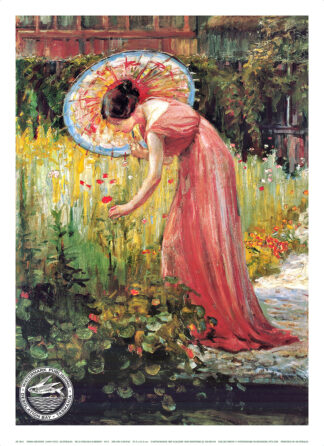MEESON, Dora

Dora Meeson (1869-1955) was born on 7th August 1869 at Hawthorn, Melbourne, Victoria. The daughter of John Thomas Meeson, a schoolmaster, and later barrister and his wife Amelia, née Kipling. Dora grew up in New Zealand, returning to Australia in 1896, she studied art at the National Gallery School, Melbourne. The Academie Julian in Paris under Benjamin Constant and Laurens and Slade School of Art, London.
She became engaged in France to Australian artist George James Coates (1869-1930) born on 9th August 1869. They could not afford to marry until 23rd June 1903, three years after their move to London. They resolved not to have children and to devote themselves to their respective artistic careers.
Coates and Meeson established themselves in Chelsea where they became members of an extensive circle of Australian expatriate artists. To earn money they contributed black and white illustrations to Dr H. S. Williams’s Historians’ History of the World and the Encyclopaedia Britannica. Coates had exhibited ‘on the line’ at the Old Salon in Paris in 1898 and continued to show there and at the Royal Academy. Recognition did not come until after 1910, with an honourable mention at the Old Salon, prominent public notice at the 1912 Royal Academy exhibition and success at the 1913 New Salon when he was elected an associate and a member in 1927. Numerous commissions followed and soon established him as one of London’s leading portrait painters. He was a member of the Chelsea Arts Club, the International Society of Sculptors, Painters, and Gravers and the Royal Society of Portrait Painters. Dora Meeson had the distinction of being the first Australian woman artist elected a member of the Royal Institute of Oil Painters. She was also an active participant in the Suffrage movement in London.
Despite his physical prowess Coates lacked a strong constitution; when Meeson visited Australia alone in 1913 to accompany an exhibition his health collapsed and she had to return to Italy to nurse him. In 1915 he enlisted in the Territorial Royal Army Medical Corps and served as an orderly at the 3rd London General Hospital, attaining the rank of sergeant. He was discharged in 1919 as physically unfit. While never an official war artist, he produced many portrait commissions for the Australian War Memorial. These included portraits of World War I heroes and a large group portrait of Major General Sir William Bridges and his staff in Egypt—on which Coates and Meeson worked after returning to Australia in 1921-22.
George James Coates also painted portraits of Canadian war heroes.
Neither artist responded to developments in art after impressionism. Their work remained firmly grounded in strictly representational modes. Primarily a portrait painter, the diffident and unassuming Coates was not inclined to challenge accepted assumptions about art, despite his admiration for Whistler, Dégas and Puvis de Chavannes. His realism emphasized a harmonious range of low tones and his approach was painstaking and obsessive. While able to handle large-scale works, his best portraits were more intimate such as ‘Arthur Walker and his brother Harold’ (1912) which reveal a sensitive response to character. Dora Meeson is best known for her many fine impressions of the River Thames, a number of which were acquired after 1945 by the Port of London Authority.
Coates died suddenly in London of a stroke on 27th July 1930. A memorial exhibition of his work was opened in May 1931 at the New Burlington Galleries by Lord Birdwood.
Dora continued her active artistic career until her death in London on 24th March 1955. The two were buried together in Rye cemetery.
Showing the single result
Showing the single result

